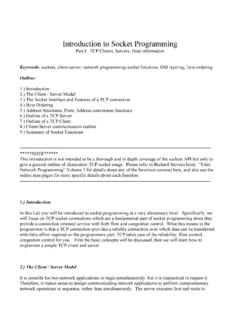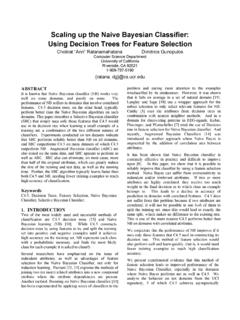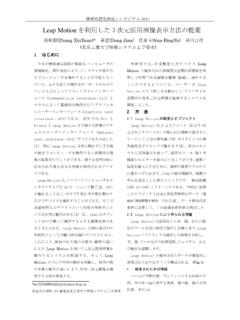Transcription of Consumer RGB D Cameras and their Applications
1 Consumer RGB-D Cameras and their Applications Krystof Litomisky University of California, Riverside Spring 2012 Introduction In November 2010, Microsoft released the kinect RGB-D sensor as a new Natural User Interface (NUI) for its XBOX 360 gaming platform. The kinect , like other RGB-D sensors, provides color information as well as the estimated depth for each pixel. At $150, the kinect is an order of magnitude cheaper than similar sensors that had existed before it. This has dramatically reinvigorated interest in RGB-D sensors and their Applications in areas such as Natural User Interfaces, reconstruction and virtual reality, or 3D mapping. The purpose of this document is to provide an overview of currently-available Consumer RGB-D sensors, Applications for which these sensors are being used, and various supporting frameworks (such as libraries and SDKs).
2 The main focus of this document is on the Applications of RGB-D sensors to three-dimensional mapping. Krystof Litomisky Consumer RGB-D Cameras and their Applications 2 Table of Contents Introduction .. 1 Table of Contents .. 2 1. Consumer RGB-D Sensors .. 3 Technology .. 3 Devices .. 4 Microsoft kinect .. 4 Asus Xtion PRO LIVE .. 5 The Leap .. 6 Depth Resolution .. 6 2. 3D Mapping and Control Applications .. 8 RGB-D 8 Interactive 3D Modeling of Indoor Environments .. 9 Autonomous 10 Realtime Visual and Point Cloud SLAM .. 13 Towards a Benchmark for RGB-D SLAM .. 14 3. Reconstruction and Virtual Reality .. 14 KinectFusion .. 15 4. Natural User Interfaces (NUIs) .. 15 5. Libraries and SDKs .. 16 Point Cloud Library (PCL) .. 16 Microsoft kinect 17 OpenCV .. 18 OpenNI .. 18 References .. 19 Krystof Litomisky Consumer RGB-D Cameras and their Applications 3 1.
3 Consumer RGB-D Sensors RGB-D sensors combine RGB color information with per-pixel depth information. Sensors that provide such data have existed for years, including the Swiss Ranger SR4000 and PMD Tech products (see ). However, these sensors cost around $10,000 each. By contrast, new Consumer RGB-D sensors cost less than $200. The per-pixel depth sensing technology that is used in Consumer RGB-D Cameras was developed by PrimeSense ( ). The technology is patented (United States Patent US7433024). The technology is licensed for use in the commercially-available Microsoft kinect and Asus Xtion PRO sensors. Both were created as Consumer products for NUI Applications . In particular, the Microsoft kinect is an Xbox accessory, and became the fastest-selling Consumer electronics device in the world after its launch in November 2010 (see ).
4 Technology Figure 1: MS kinect infrared pattern. Source: Krystof Litomisky Consumer RGB-D Cameras and their Applications 4 The PrimeSense sensor projects an infrared speckle pattern (Figure 1). The projected pattern is then captured by an infrared camera in the sensor, and compared part-by-part to reference patterns stored in the device. These patterns were captured previously at known depths. The sensor then estimates the per-pixel depth based on which reference patterns the projected pattern matches best [REF: primesense patent: ]. The depth data provided by the infrared sensor is then correlated to a calibrated RGB camera . This yields an RGB image with a depth associated with each pixel. A popular unified representation of this data is a point cloud: a collection of points in three dimensional space, where each point can have additional features associated with it.
5 With an RGB-D sensor, the color can be one such feature. Additionally, approximated surface normals are also often stored with each point in a point cloud. Devices Because Consumer RGB-D sensors were created as NUI devices, they have certain characteristics that limit their utility for mapping Applications . In particular, the field of view is much smaller than mapping-specialized sensors, and the depth resolution deteriorates notably with depth (section ). Microsoft kinect Figure 2: The Microsoft kinect with the cover taken off. Source: The standard version of the Microsoft kinect sensor is commercially available for around $150. In addition to the RGB and depth sensors, the kinect also has a microphone array, which is particularly helpful in NUI Applications . The technical specifications of the kinect sensor are in Table 1.
6 Krystof Litomisky Consumer RGB-D Cameras and their Applications 5 Field of view 43 vertical by 57 horizontal field of view Frame rate (depth and color stream) 30 frames per second (FPS) Default resolution, depth stream VGA (640 x 480) Default resolution, color stream VGA (640 x 480) Audio format 16-kHz, 16-bit mono pulse code modulation (PCM) Audio input characteristics A four-microphone array with 24-bit analog-to-digital converter (ADC) and kinect -resident signal processing, such as acoustic echo cancellation and noise suppression Table 1: Microsoft kinect technical specifications. Source: [REF: ] Asus Xtion PRO LIVE Figure 3: Asus Xtion PRO LIVE. Source: The Xtion sensor should retail for less than $200; however, as of May 2012, I have been unable to find a retailer that sells the Xtion, and it seems that it may be discontinued.
7 Asus has an Xtion PRO version, which only provides depth data, and an Xtion PRO LIVE version, which provides depth, color, and audio (using a microphone array, like the kinect ). Table 2 shows the technical specifications of the Xtion PRO LIVE sensor. Krystof Litomisky Consumer RGB-D Cameras and their Applications 6 Field of View 58 H, 45 V, 70 D Depth Image Size VGA (640x480) : 30 fps QVGA (320x240): 60 fps Resolution SXGA (1280*1024) Interface Table 2: Asus Xtion PRO LIVE technical specifications. Source: #specifications. The Leap The Leap sensor is much smaller than either of the above RGB-D sensors, and is designed for much finer NUI on a smaller scale. It is not available yet, but Leap Motion, the company behind The Leap, is accepting preorders. For more information, see Depth Resolution Figure 4: Microsoft kinect depth resolution vs.
8 Depth (Khoshelham & Elberink 2012). Theoretical random error is shown in red (bottom curve), while the theoretical resolution is shown in blue (top curve). The accuracy of the depth data provided by Consumer RGB-D sensors deteriorates as the objects in the scene get further away from the sensor. This is not a significant issue for NUI Applications , where the user can stay at a range that is suitable for the sensor, but it is important for mapping Applications . Krystof Litomisky Consumer RGB-D Cameras and their Applications 7 Khoshelham and Elberink looked at how the depth resolution of data from the Microsoft kinect changes as objects get further from the sensor (Khoshelham & Elberink 2012). In particular, they pointed the sensor at a door that was a known distance away, and looked at the standard deviations of the distances of points provided by the sensor from the true plane.
9 Figure 4 summarizes their results. My own previous experiments confirm this. Figure 5 shows the depth data with approximated surface normals of a mannequin captured at different distances. As in the experiments of Khoshelham and Elberink, the depth resolution gets dramatically worse as the object being observed gets further from the sensor. Figure 5: Depth data of a mannequin captured from the front and shown from the side. From left to right, the mannequin is shown as captured at m, 3 m, 4 m, 5 m, and 6 m. Lange et al. compare the quality of the depth data provided by the kinect to some commercial sensors designed specifically for robotics Applications (Lange et al. 2012). A summary of their results is in Table 3. The most noteworthy observation regarding this data is the significantly higher standard deviation of repeated measurements at known distances, particularly as the distance from the sensor increases.
10 At a distance of 4 meters, the kinect had a standard deviation of , compared to just 6mm for the Krystof Litomisky Consumer RGB-D Cameras and their Applications 8 SwissRanger 4000 and 4mm for the PMD CamCube Nevertheless, the authors are convinced that the kinect s low price will make it an attractive option. Table 3: comparison of depth data quality of different sensors (Lange et al. 2012). 2. 3D Mapping and Control Applications Intro paragraph to using Consumer RGB-D sensors for SLAM: limitations due to field of view, max distance from sensor, quantization, huge amount of data RGB-D Mapping Henry et al. got access to a prototype of an RGB-D sensor directly from PrimeSense before the sensor became commercially available; this led to work published in the International Symposium on Experimental Robotics (ISER) (Henry et al.)











